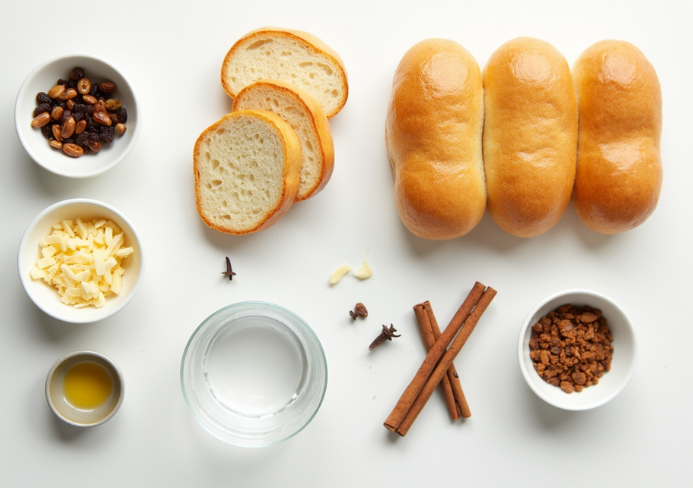Mexican Bread Pudding Recipe – Capirotada
Capirotada is a traditional Mexican bread pudding that’s as rich in flavor as it is in history. This beloved dessert combines layers of toasted bread, cinnamon-spiced piloncillo syrup, nuts, raisins, and cheese into a comforting, symbolic dish enjoyed especially during Lent.
Table of Contents
This dish is more than just a dessert — it’s a celebration of Mexican cultural heritage and Catholic tradition. During Holy Week, families across Mexico gather to prepare capirotada as part of a meatless meal, honoring centuries-old customs that blend Spanish, Indigenous, and religious influences. Learn more about its significance in Lent from Catholic Culture’s guide to Lenten food traditions.
Origins and History of Capirotada
The roots of capirotada trace back to 15th-century Spain, where early bread puddings were used to make use of stale bread. When Spanish colonizers brought the recipe to Mexico, it merged with Indigenous ingredients like piloncillo and native fruits. Over time, it evolved into a dish rich in Catholic symbolism:
- Bread represents the body of Christ
- Cinnamon sticks resemble the wooden cross
- Cloves symbolize the nails
- Cheese stands for the Holy Shroud
Today, capirotada is a staple in Mexican households during the Easter season. You can explore more about its transformation in this article on the history of Mexican cuisine.
Key Ingredients and Symbolism
Each element in capirotada is intentional and rooted in cultural meaning. Here’s a look at the essentials:
- Bolillo bread: Day-old or toasted Mexican white rolls
- Piloncillo syrup: Unrefined cane sugar that adds deep molasses flavor
- Cinnamon and cloves: Infuse the syrup with warm spice
- Raisins and dried fruit: Add sweetness and texture
- Nuts (pecans, peanuts, almonds): Offer crunch and richness
- Cheese (queso fresco or mild cheddar): Melts into the pudding and adds creaminess
You can substitute ingredients as needed, but using authentic components enhances the experience and honors the tradition.

Step-by-Step Capirotada Recipe
This recipe serves about 8 people.
Ingredients:
- 5 bolillos or French bread rolls, sliced and toasted
- 2 cups piloncillo, chopped or shaved
- 3 cups water
- 1 cinnamon stick
- 3-4 cloves
- 1/2 cup raisins
- 1/2 cup chopped nuts (pecans or peanuts)
- 1 cup shredded cheese (queso fresco or cheddar)
- 2 tablespoons butter or oil for greasing
- Optional: dried banana, coconut, pineapple slices
Instructions:
- Preheat oven to 350°F (175°C). Grease a medium baking dish.
- Make the syrup: In a saucepan, bring water, piloncillo, cinnamon, and cloves to a boil. Reduce heat and simmer until thickened slightly (about 10–15 minutes). Strain and discard solids.
- Layer the pudding:
- Place a layer of toasted bread at the bottom of the dish.
- Sprinkle raisins, nuts, and cheese.
- Pour syrup to moisten.
- Repeat layers until ingredients are used up.
- Bake uncovered for 30–35 minutes or until bubbling and golden on top.
- Let cool slightly before serving. It’s delicious warm or cold.
Regional Variations
Different regions of Mexico bring their own flair to capirotada:
- Northern Mexico often uses cheddar cheese and pecans.
- Southern states may add tropical dried fruits or coconut.
- Some versions include bananas or even sprinkles for a festive touch.
Health and Dietary Adaptations
If you’re looking to enjoy capirotada with fewer calories or dietary restrictions:
- Use gluten-free bread alternatives
- Choose dairy-free cheese or omit it entirely
- Opt for a lighter syrup using less piloncillo or maple syrup
- Replace nuts with seeds for allergies
You can also refer to this nutritional guide to piloncillo to understand its benefits and how it compares to other sweeteners.
How to Serve and Store Capirotada
- Capirotada is best served warm or at room temperature.
- Refrigerate leftovers in an airtight container for up to 4–5 days.
- To reheat, place in a microwave or oven with a splash of milk or syrup.
- Yes, you can freeze capirotada — just wrap it tightly and reheat slowly.
Capirotada and Lent: A Spiritual Connection
This dessert isn’t just food; it’s a religious expression. Because Lent prohibits meat on certain days, capirotada provides a filling and symbolic alternative. The act of preparing it becomes a spiritual ritual for many families, especially during Holy Week.
Common Mistakes and Pro Tips
- Avoid soggy pudding: Use well-toasted or stale bread
- Balance flavors: Don’t oversaturate with syrup — moisten, don’t drench
- Don’t skip the cheese: It may sound odd, but it rounds out the flavor beautifully
Capirotada in Mexican-American Culture
In Mexican-American communities, capirotada is a nostalgic dish. Passed down through generations, it ties families to their roots. While some may tweak the ingredients to suit local tastes, the heart of the dish — bread, syrup, and tradition — remains unchanged.
Frequently Asked Questions
What does capirotada taste like?
Capirotada tastes like a rich, sweet bread pudding with warm spices, melty cheese, and a sticky caramel-like syrup. It’s a combination of savory and sweet, unlike most American-style bread puddings.
Why is capirotada eaten during Lent?
It’s meatless and uses symbolic ingredients, making it suitable for observance during Lent, especially on Good Friday.
Is capirotada served hot or cold?
Both ways are common, though many prefer it slightly warm with the cheese soft and syrup gooey.
Can you freeze capirotada?
Yes! Wrap tightly in foil or freezer-safe containers. Thaw and reheat gently.
What kind of cheese is best for capirotada?
Mild cheddar, queso fresco, or even Monterey Jack work well. The key is mild flavor and good meltability.
Is capirotada the same as bread pudding?
Yes and no. It’s a form of bread pudding but with distinctive ingredients and deep religious meaning, setting it apart from Western versions.
Capirotada is more than a recipe — it’s a connection to family, faith, and flavor. Whether you’re making it for the first time or carrying on a tradition, this beloved Mexican dessert will bring warmth to your table and history to your plate.
PrintMexican Bread Pudding Recipe – Capirotada
- Total Time: 55 minutes
- Yield: 8 servings 1x
- Diet: Vegetarian
Description
This symbolic version of capirotada is a classic Mexican bread pudding made with toasted bolillo, piloncillo syrup, cheese, and dried fruits — each ingredient carrying deep cultural and religious meaning.
Ingredients
- 5 bolillo rolls or French bread, sliced and toasted
- 2 cups piloncillo, chopped or shaved
- 3 cups water
- 1 cinnamon stick
- 3–4 cloves
- ½ cup raisins
- ½ cup chopped nuts (pecans or peanuts)
- 1 cup shredded cheese (queso fresco or cheddar)
- 2 tablespoons butter or oil (for greasing dish)
- Optional: dried banana, coconut flakes, pineapple slices
Instructions
- Preheat the oven: Set oven to 350°F (175°C) and grease a medium baking dish with butter or oil.
- Make the syrup: In a saucepan, bring water, piloncillo, cinnamon, and cloves to a boil. Reduce heat and simmer for 10–15 minutes until slightly thickened. Strain to remove solids and set syrup aside.
- Layer the capirotada: In the prepared baking dish, begin with a layer of toasted bread slices. Sprinkle with raisins, chopped nuts, and shredded cheese. Pour a generous ladle of syrup over the layer to moisten. Repeat the process until all ingredients are used.
- Bake: Bake uncovered for 30–35 minutes, or until bubbling and golden on top.
- Cool and serve: Let cool slightly. Serve warm or cold according to preference.
Notes
Each ingredient in capirotada has symbolic meaning: the bread represents the body of Christ, the syrup his blood, the cinnamon sticks the cross, and the cloves the nails. Using authentic ingredients preserves this culinary and cultural tradition.
- Prep Time: 20 minutes
- Cook Time: 35 minutes
- Category: Dessert
- Method: Baked
- Cuisine: Mexican
Nutrition
- Serving Size: 1 portion
- Calories: 340
- Sugar: 26g
- Sodium: 180mg
- Fat: 14g
- Saturated Fat: 7g
- Unsaturated Fat: 5g
- Trans Fat: 0g
- Carbohydrates: 45g
- Fiber: 2g
- Protein: 8g
- Cholesterol: 25mg
Keywords: capirotada, symbolic dessert, Mexican bread pudding, lent recipe, piloncillo, queso fresco






